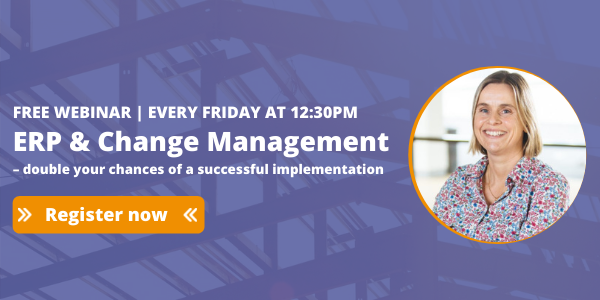Implementing a new ERP System can be career defining for IT Directors. This type of complex change project can go on for years and is most definitely the marathon of IT Solutions. The dedicated time, resource and expense involved means the deployment needs to be a success. So why are common ERP mistakes made time and again?
We know an effective ERP will synchronise company operations across every department… but there are so many horror stories of ERP implementation mistakes and ERP implementation failure statistics. We know that only 52.6% of ERP implementations are deemed a success. So how can you make sure you know what the common ERP implementation mistakes are and how to avoid them?
Often the ERP technology works, but the solution is not configured correctly or adopted by users. Here are five themes of change management that are critical to the success of your implementation:
- Not capturing current state processes, nor defining future state processes before configuration begins.
Like any complex change, capturing the impacts before they happen will mitigate risk. A current state process map will enable you to see how a process is working and what the knock-on impact is. Identify each step and decision point in the current process and determine what needs to be re-engineered once the ERP is up and running.
We recommend you don’t replicate your current processes on a new ERP solution. Instead, focus on developing common and simple processes and only have exceptions where necessary. If it sounds too complicated – it probably is. ERP technology platforms are best of breed so utilise what it has to offer ‘out of the box’.
- Onboarding a change network too late.
There will be a personal and cultural impact to introducing a new ERP System. That is the certainty with any structural or process change. Putting in place the tools and techniques to shepherd the change will make for a smoother transition. ERP Focus reported that 95% of the companies who failed to implement their ERP System dedicated less than 10% of total budget to change management.
To find out why your ERP implementation isn’t going to plan, check here.
- Not tailoring communications.
One size most definitely does not fit all. Thinking about the role of the individual and the impact the ERP Implementation will have on their day to day working day will be key to providing effective and relevant communication. Keep your stakeholders engaged and informed with information targeted to them, what do they need to know and when do they need to know it? You can learn more in our blog about planning effective communication.
- Underestimating the complexity and power of data
Accurate, reliable and real-time data will be the make or break of your new ERP solution. So as well as system set up and configuration, and processes, make sure you look at the data requirements from the outset. What data do you want to capture and how will you use this to report on performance and inform decision making? What data do you have in your legacy system and what needs to be ported across and in what structure? Making sure master data and operational data is entered correctly is key to ERP success – and that is where training comes in to play.
To learn about the quick tips for a successful ERP implementation, check here.
- Only producing process-based training and neglecting role based.
Training must cover the system as well as process. You need to consider this as a day in the life of the user, rather than training them on only a segment of the system. Provide a mixture of role-based and process-based materials to ensure users understand how to do their bit, while maintaining an appreciation of the upstream and downstream implications of their actions.
Classroom training lends itself well to process based training – you can have more people in a room with slight variation in role, and you can simulate handoffs and workflows in your training environment. Follow this up with how-to videos and quick reference guides which can then fill in the gaps, making sure users understand the nuances of their bit only.
- Underestimating business readiness activity volumes and not securing sufficient business project support up front.
Realising the benefits of the new ERP System will only be possible if there is receptiveness to the proposed change. Business readiness activity can be a valuable exercise for identifying potential pitfalls you might encounter along the implementation journey. Stakeholders in the project need to be strong advocates to champion the change.
We have years of experience delivering complex change to organisations like yours and would be happy to offer a free consultation to help identify risks which could lead to mistakes. For more information contact EstherM@NineFeetTall.com
Sources:
Erp Implementation process | 10 Steps for Successful ERP Implementation (bassaminfotech.com)
https://www.erpfocus.com/ten-erp-failure-statistics.html


